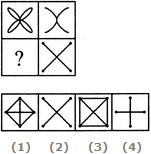Discussion
Home ‣ Non Verbal Reasoning ‣ Figure Matrix See What Others Are Saying!
- Question
Select a suitable figure from the four alternatives that would complete the figure matrix.

Options- A. 1
- B. 2
- C. 3
- D. 4
- Correct Answer
- 3
ExplanationThe second figure is a part of the first figure (but is not exactly the same as the first figure). - 1. Select the figure which satisfies the same conditions of placement of the dots as in Figure-X.

Options- A. 1
- B. 2
- C. 3
- D. 4 Discuss
- 2. Choose the correct alternative from the given ones that will complete the series:

Options- A. 1
- B. 2
- C. 3
- D. 4 Discuss
- 3. What will come in place of?:

Options- A. 1
- B. 2
- C. 3
- D. 4 Discuss
- 4. A piece of paper is folded and cut as shown below. From the responses indicate how it will appear when opened:
Options- A. 1
- B. 2
- C. 3
- D. 4 Discuss
- 5. Select the one which is different from the other three responses
Options- A. 1
- B. 2
- C. 3
- D. 4 Discuss
- 6. In each of the following questions which of the answer figures is exactly the mirror image of the question figure when the mirror is held at the given point
Options- A. 1
- B. 2
- C. 3
- D. 4 Discuss
- 7. Which answer figure will complete the pattern in the question figure?
Options- A. 1
- B. 2
- C. 3
- D. 4 Discuss
- 8. Choose the figure which is different from the rest.
 (1) (2) (3) (4) (5)
(1) (2) (3) (4) (5)
Options- A. 1
- B. 2
- C. 3
- D. 4
- E. 5 Discuss
- 9. Select a suitable figure from the answer figures that would replace the question mark (?) from question figure.
Options- A. 1
- B. 2
- C. 3
- D. 4 Discuss
- 10. Find out the next series from the
answer figures (1, 2, 3, 4, 5) that follows the sequence of the questions figures:

Options- A. 1
- B. 2
- C. 3
- D. 4 Discuss
More questions
Correct Answer: 4
Explanation:
Correct Answer: 4
Explanation:
On the basis of given figures in above question , we can see that
From first figure to second figure two black dots are added in the upper part and two white circles in the lower part. The same procedure is continued in the subsequent figure.
Hence , figure ( 4 ) will come on the place of ? from answer figures .
Correct Answer: 3
Explanation:
As per the given figure in above question, it is clear that
In each subsequent figure the shaded part and circle move one step in clockwise direction.
Therefore , figure ( 3 ) will come on the place of ? in question figure .As shown in answer figures .
Correct Answer: 4
Explanation:
NA
Correct Answer: 2
Explanation:
Except in figure (2), in all other figures there are four line segments with small circle. But all other figures are different to figure ( 2 ) .
Correct Answer: 1
Explanation:
According to given question figure ,
we can say that the mirror image always be opposite the original image across the given line. Given image will become opposite in mirror across the given line MN.As shown in given below .
Correct Answer: 1
Explanation:
NA
Correct Answer: 1
Explanation:
Correct Answer:
Explanation:
Half of the figure is missing and the remaining half is in shaded form.
Correct Answer: 1
Explanation:
In each step, the upper element is lost, the middle element reduces in size and becomes the upper element, the lower element enlarges and become the middle element and every time a new element appears at the bottom of the figure.
Comments
There are no comments.Programming
Copyright ©CuriousTab. All rights reserved.
